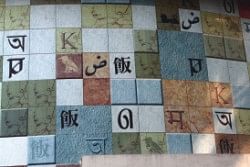|
Postscript
Sounds of Mother Tongues
AASHA MEHREEN AMIN
As February 21 approaches and we commemorate the day 'with due solemnity' as BTV news will put it, there is no denying that it will be a celebration of the much lauded International Mother Language Day. The Ekushey Boi Mela is the traditional way we remember this month and revel in a language that determines our identity. One wishes, however, that not only the formal Bangla of our scribes and academics be celebrated but also the different dialects of Bangla that is spoken all over this nation.
 |
Photo: Zahedul I Khan |
Some people may call it the 'crude version' of Bangla, one that should be confined to the place of origin and not be allowed to pollute the standard Bangla. Others are proud of their heritage and even tend to let it creep into the city dialect. Hence the jarring mixture of 'z' and 'j' leading to complete confusion: zanaza, Zigatola and Zamrul (janaza, Jigatola and Jamrul). Similarly 'ful' instead of 'phul' (flower). It doesn't make sense as there is no 'z' or 'f' sound in the Bangla alphabet. Nor is there the 'v' sound yet people say things like 'vai valo achchen?' (Bhai bhalo achhen? Brother, are you well?). Perhaps it is from the 'v' sound in Sanskrit that has somehow slipped into our genetic makeup.
Of course one has to acknowledge a few ground realities. Many foreign words such as chador, balish and bereshta (possibly Persian) have seeped in. Like our cuisine, our language is infused with many influences and dialects have developed in mysterious ways.
How for instance did the word for bachcha (baby) become abuidya in some parts of Mymensingh, sawal in Barisal and gura foa in Chittagong? In Chakma language it is chigan guro.
These days Dhaka is the melting pot for migrants from many different districts who bring with them, their habits, lifestyle and of course, dialect. Sometimes 'original' Dhakaites, that is, those who were born and brought up in the capital, find their compatriots speaking in a language they seldom understand. It takes a while, for instance to decipher: hype hani hor se toi ohono bao korte fari nai. In regular Bangla this is pipe e pani porechche kintu ber kora jachche na (there is water in the pipe, but I still haven't been able to extract it). If any of you are wondering why this reference to hosepipe, it is rather irrelevant for the present purpose.
Other words that one hears now and then are easier to decode such as 'niste' (niche or downstairs or under), urfe (upore or above) and aysuin (ashechho? You here?).
Then of course there are those words the urban Dhakaites are only too familiar with. The dialect used by Dhakaiyas from Old Dhaka is certainly worth mentioning. Here's a Dhakaiya joke. A Dhakaiya goes to a restaurant and asks for 'chicken soup', which is really the deshi rather than English version of the item, to be had with rich, fluffy, parathas. When the meal arrives, the Dhakaiya says in disgust: Eyda re koy murgir chhup? Halaar eyda to mone koy murgi panir bhitre lor payra gechche (Is this chicken soup? Man, this looks like the chicken has just run through some water).
Thus while the purists struggle to keep Bangla intact and unadulterated by foreign influences, urban radio jockey distortions (like 'joss', 'fatafati', 'joteeel bhab' and 'kotheen prem') and local dialects, we cannot deny the fact that in this little country with such a big population, there are languages as diverse and peculiar as the people. They are all mother languages, the first words that a human being utters and that tie a person to the land of birth. Whether it is standard Bangla, Sylheti or Marma, they should all be celebrated and preserved.
Copyright
(R) thedailystar.net 2010
|

